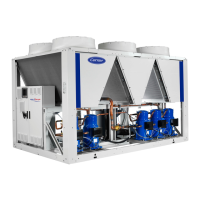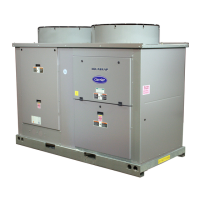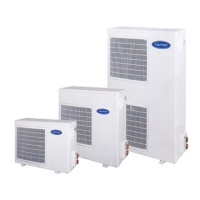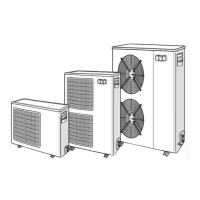14
14 [2]
occu
unoc
Forc
-
Occupied: cooling setpoint 1 is active
Unoccupied: cooling setpoint 2 is active
The value shall be displayed in turn with ‘Forc’ when the unit is in CCN control and if this variable if forced through CCN.
15 ±nn.n °C This is the current cooling/heating setpoint: cooling/heating setpoints 1, 2 or ice storage setpoint.
16
±nn.n
Forc
°C
This is the setpoint used by the controller to adjust the temperature of the leaving or entering water (according to
conguration).
Control point = active setpoint + reset. See section 5.6
The value is displayed in turn with ‘Forc’ when the unit is in CCN control and if this variable if forced through CCN.
17 ±nn.n °C Water temperature that the unit tries to maintain at the control point.
18 n Heat reclaim sequence indicator, circuit A (option).
19 n Heat reclaim sequence indicator, circuit B (option).
[1] This item is masked when nil.
[2] This item is displayed in certain unit congurations only.
1 Delay at start-up active The delay at start-up operates after the unit has been switched on. If the delay has not expired, the mode is
active. The delay is congured in the User Conguration 1 menu.
2 2nd cooling/heating setpoint active The second cooling/heating setpoint is active. See section 5.6.1
3 Setpoint reset active In this mode, the unit uses the reset function to adjust the leaving water temperature setpoint.
4 Demand limit active In this mode, the demand at which the unit is authorised to operate is limited.
5 Ramp loading active Ramp loading is active. This item is referenced to the allowed low and high temperature limits, controlled at the
water heat exchanger in order to prevent compressor overloading. Ramp function must be congured (see
User Conguration 1 menu). Ramp values can be modied (see Setpoint menu).
6 Water heat exchanger heater active The water heat exchanger heater is active.
7 Evaporator pump reversal in eect The unit is tted with two evaporator water pumps and reversal between pumps is in eect.
8 Evaporator pump periodic start The unit is stopped and the pump is started each day at 14.00 p.m. for two seconds. This function needs to be
congured in the User Conguration 2 menu.
9 Night mode (low noise level) The night mode (low noise level) is active. The number of fans is reduced (if operating conditions allow) and
unit capacity can be limited.
10 Unit in SM control Unit is in control of a System Manager (FSM, CSM III or HSM).
11 Master/slave link active Unit is connected to a secondary unit by a master slave link and the master/slave modes are active.
12 Auto heating/cooling changeover active If the unit is in auto mode, the heating/cooling changeover is automatic, based on the outdoor temperature.
13 Free cooling mode active The free cooling mode is active.
14 Heat reclaim mode active The heat reclaim mode is active.
15 Electric heating stages active The electric heating stages are active.
16 Low water entering temperature protection
in heating mode
The unit is in heating mode and compressor start is not authorised, as the entering water temperature is below 10°C.
17 Boiler active The unit controls a boiler and this is operating.
18 Ice storage mode active The unit operates in cooling mode and the ice storage mode is active.
19, 20 Defrost 19 = circuit A, 20 = circuit B. The unit is in heating mode, and the defrost sequence is active on the relevant circuit.
21, 22, 23 Low suction temperature protection 21 = circuit A, 22 = circuit B, 23 = circuit C. Protection for evaporator low suction temperature circuit is active. In
this mode, circuit capacity is not authorised to rise and the circuit can be unloaded.
24, 25, 26 Hot gas protection 24 = circuit A, 25 = circuit B, 26 = circuit C. Hot gas discharge protection is active. In this mode, the circuit
capacity cannot increase, and the circuit may be unloaded.
27, 28, 29 High pressure protection 27 = circuit A, 28 = circuit B, 29 = circuit C. The circuit is in high pressure protection mode because the HP
protection threshold has been exceeded. Circuit has been unloaded and the circuit capacity is not authorised
to rise.
30, 31, 32 Low superheat protection 30 = circuit A, 31 = circuit B, 32 = circuit C. The circuit is in the low superheat protection mode to prevent the
compressors drawing in liquid refrigerant.

